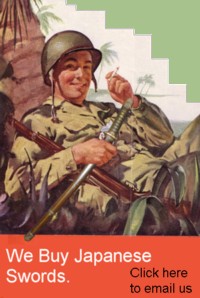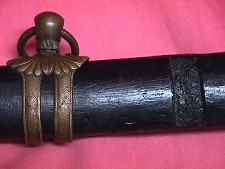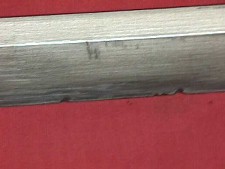|
WWII JAPANESE ARMY SAMURAI SWORD - KATANA - #6
This is a WWII Samurai sword. As issued to Japanese armed forces during WWII. The simplicity of design,
strength and beauty has made the sword famous. It is employed in movies and commercials quite often,
propelling it into one of the top military collectibles.

THE FITTINGS
The fittings found on this sword are typical of the WWII era. The pommel displays the cherry blossom on its top while the side has a circular pattern (below-left).
The Tsuba is of very rough construction, this implies that it was produced late in the war when the materials were getting more scarced and were dedicated to the construction of weapons (below-right).


The scabbard is outfitted with a brass hanger and tip ornament. Notice how just above the scabbard there
is an indentation on the wood. This is where a wooden, hollowed piece would be placed to allow the soldiers
to secure the sword via a cloth sash.

|
The Samurai sword has a very rich history. The sword has been manufactured for several centuries and continues
to be produced today. The sword represented more than just a weapon. It was the soul of the Samurai warrior.
When attempting to identify the type of sword you have It is important to keep in mind that the fittings of
a sword (scabbard, handle, crossguard. etc.) may be identical from one sword to another. The reason why is
because during WWII the same fittings were used in all Army swords, Navy swords, etc. Armed forces are all
about uniformity. They strive to make everything the same.
This is the reason why a sword cannot be identified merely by its external appearance.
Understanding the different components that make up the Samurai sword is the first step in figuring out the
type of sword you have. That is the reason why we have created the
Understanding the Samurai sword section as a means to
provide a novice with the basic knowledge to start the path of determining the questions everyone has;
who made the sword, how old it is nad how much it is worth.
|
The blade is hand made. Some minor nicks can be seen in the edge of the sword. In addition, the
upper section of the blade is bent. When force is applied to a blade it will bend or crack. Hand
made blades bend because they were constructed by folding the metal onto itself
several times.

|
WE BUY JAPANESE SWORDS - All types of Japanese edge weapons. Whether it is a WWII era Samurai sword or an
older type of blade.
The process gets started by you sending us an
Email .
We will respond to your inquiry normally within 24 hours and in many cases much faster.
We can tell you what you have, what it is worth and how much we can pay you.
One sword or an entire collection -
Email Us .
|
 |
The Hamon (edge) is no longer visible. It appears that the blade has been sharpened improperly
removing this characteristic of the blade. This is one of the many reasons why untrained
individuals should not sharpen a Samurai sword.
 |
The scabbard used with this sword is known as the "traditional" type. The body consists of a wooden
structure finished in black lacquer. Many of the Samurai swords taken to battle in WWII were outfitted
with wooden scabbard inside a metal shell.
Traditional scabbards were equipped with more ornate fittings. The drag placed on the tip has a side
hollowed design with a flower in the center of a circle.
|
 |
THE BLADE
|
This page is a recognition and identification guide for Samurai swords.
Multiple detailed photos of a specific sample are provided. Descriptions point
out clearly defined points that should be noted.
One of the most commonly asked questions is "How much is my Samurai Sword worth?".
A price guide is included here to address this question. The value of the swords is
reviewed over a period of several years. A trend can be observed. The present worth
of the edge weapons in the collector's market is illustrated.
This service is provided free of charge to the visitor/enthusiast courtesy of
MilitaryItems.com,
a company dedicated to the preservation of military history and to providing quality
military antiques and collectibles to museums, institutions and the general public.
|
|
 |
The photo on the left shows a brass Habaki with angled perpendicular lines. This design was known
as the "rain pattern".
|
 |
 |
The tang (see above photo) has three holes drilled in place. Normally two of the holes are used to secure the
blade to the handle via wooden pegs. The fact that you have multiple holes indicates the blade was shortened at some point.
The size and shape of the tang are factors that help determine the period or school where the blade
was manufactured. The presence of multiple holes indicates that the blade has been shortened.
|
The reason why blades are shortened is to make an older "family blade" fit the handle and/or scabbard
for use in the military during WWII.
|
By the Numbers
It is next to impossible to determine the exact number of Samurai swords that were produced and issued to
Japanese soldiers during the war. However, thanks to the record keeping maintained by the US Armed Forces,
it is possible to estimate how many swords were actually shipped home.
 |
There were over 500,000 Samurai swords were brought back home as souvenirs from the war.
There are several caviats to this number.
|
 |
For example, some soldiers took souvenirs and shipped them home circumbenting the established process.
Some of the swords were brought back inside duffle bags without anyone knowing except for the soldier who
captured the sword. This fact would clearly affect the final count.
The number also does not account for swords that were taken by Allied soldiers from other countries.
Collecting Samurai swords
Collecting Samurai swords is a field that has been growing since the days the GI's rummaged around Asia
bringing back military souvenirs. Japanese soldiers carried many of these swords when they went to
battle. Once the soldier was killed or captured, the Americans would take the edge weapons as war trophies.
Eventually all these pieces came back to the United States where military history enthusiasts began to collect them.
 |
In trying to determine if you should collect Samurai swords there are certain factors that should be
considered.
The adjacent table outlines some of the advantages and disadvantages of collecting the Samurai swords.
|
 |
This Samurai Sword may be currently reproduced.
It is becoming more difficult to be able to tell the fake ones from the real ones because
the quality of the reproductions is improving. The collector must become familiarized with
the construction style and materials employed in the manufacturing of this item.
Attention to the details is critical in order to be able to determine the authenticity of
the collectible.
If you have an interest is seeing other Japanese Samurai swords, you can do so by going to our
Japanese Samurai Swords Price Guide
identification guide. Where we cover Samurai swords from all periods.
| 




